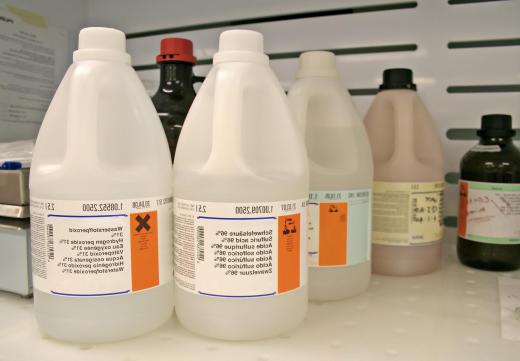What Is the Connection between Zinc and Sulfuric Acid?
The reaction between zinc and sulfuric acid is a common redox, or reduction-oxidation reaction. Redox reactions describe the flow of energy, in the form of electrons, in a reaction. Zinc and sulfuric acid are connected by a consistent tendency for zinc to donate electrons to the hydrogen in sulfuric acid and then bond with the remaining sulfate to form zinc sulfate and hydrogen gas. This reaction is frequently studied in chemistry classes because it clearly demonstrates the transfer of electrons between the acid and the metal.
When zinc and sulfuric acid are combined in a solution, the zinc acts as a reducing agent and donates electrons to the hydrogen ions provided by the sulfuric acid. In this way zinc is said to be oxidized as it loses electrons and hydrogen is reduced as it gains them. The sulfate ions then bond with the zinc, forming zinc sulfate, and the hydrogen is released as hydrogen gas.

Electrolytes in chemistry are good sources of conductivity as they are rich in ions which attract electrons from other substances. Aqueous sulfuric acid acts as an electrolyte when the bonds between the hydrogen and sulfate ions that form the acid are released in water. These ions are then free to react with additional substances, such as zinc, and the resulting transfer of electrons produces energy. In a zinc and sulfuric acid reaction, sulfuric acid is the electrolyte that triggers zinc to release its electrons.
Electricity is produced by the flow of electrons between zinc and hydrogen within the electrolytic sulfuric acid solution. In a pure reaction this energy is lost as heat. During laboratory demonstrations the electron activity is visible as active bubbling of the solution. The addition of another metal, such as copper, intensifies the reaction and results in more rapid bubbling. This energy can be harnessed by building a circuit between the metals instead of letting them react normally.
An example of this is a battery. Batteries work by connecting two metals bathed in electrolytic solutions. In a battery, zinc is kept in one chamber and another metal is kept in a separate one. Both are bathed in an electrolyte to trigger the release of electrons which flow along a circuit within the battery which harnesses the energy.
AS FEATURED ON:
AS FEATURED ON:











Discuss this Article
Post your comments